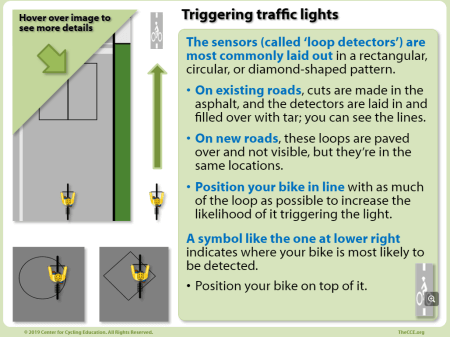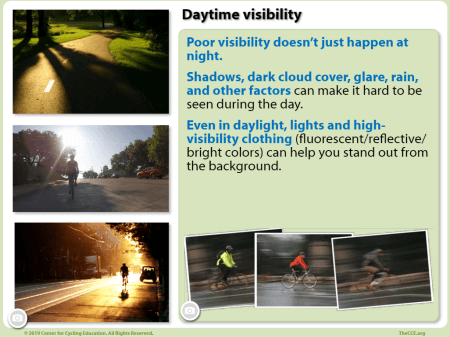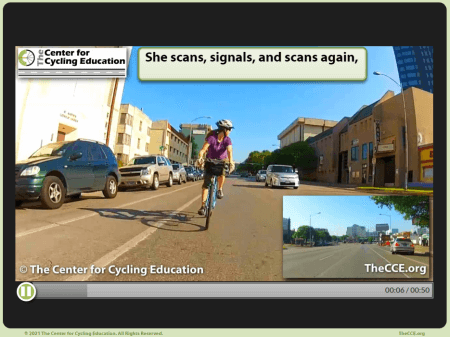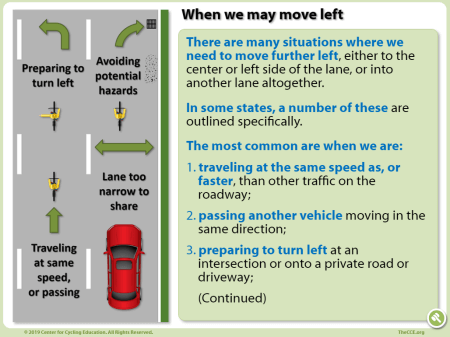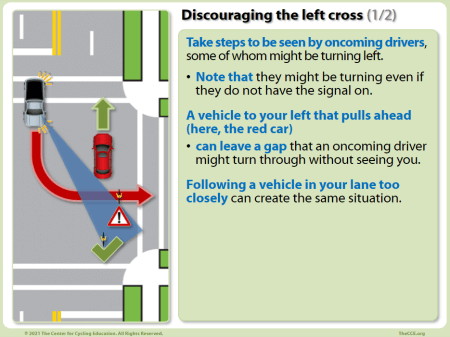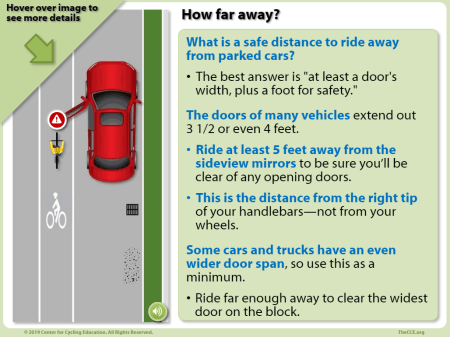There are no federal laws outlining the rules of the road. Instead, each state has its own set of traffic laws. In many cases, these are based at least in part on the Uniform Vehicle Code.
The Code of Virginia: Motor Vehicles governs bicycling in the state.
In addition to this, many counties, cities/towns, campuses, & military bases may have their own traffic regulations, usually known as ordinances or codes.
These local regulations may not take away any rights listed in the state traffic laws, unless this option is expressly permitted by the state. They also may not permit a person riding a bike to do anything prohibited by state law.
See below for the state laws that influence your bicycle riding in Virginia.
Cycling Laws » USA » VA – Virginia » Code of Virginia: Motor Vehicles
(Retrieved from the Virginia Legislative Information System website on September 19, 2019. This is not an official version.)
Code of Virginia
Title 46.2. Motor Vehicles 
Chapter 8. Regulation of Traffic 
§ 46.2-800. Riding bicycles, electric personal assistive mobility devices, electric power-assisted bicycles, or mopeds; riding or driving animals. 
Every person riding a bicycle, electric personal assistive mobility device, electric power-assisted bicycle, moped, or an animal or driving an animal on a highway shall be subject to the provisions of this chapter and shall have all of the rights and duties applicable to the driver of a vehicle, unless the context of the provision clearly indicates otherwise.
The provisions of subsections A and C of § 46.2-920 applicable to operation of emergency vehicles under emergency conditions shall also apply, mutatis mutandis, to bicycles, electric personal assistive mobility devices, electric power-assisted bicycles, and mopeds operated under similar emergency conditions by law-enforcement officers. [See below for details.]
§ 46.2-905. Riding bicycles, electric personal assistive mobility devices, electric power-assisted bicycles, and mopeds on roadways and bicycle paths. 
Any person operating a bicycle, electric personal assistive mobility device, electric power-assisted bicycle, or moped on a roadway at less than the normal speed of traffic at the time and place under conditions then existing shall ride as close as safely practicable to the right curb or edge of the roadway, except under any of the following circumstances:
1. When overtaking and passing another vehicle proceeding in the same direction;
2. When preparing for a left turn at an intersection or into a private road or driveway;
3. When reasonably necessary to avoid conditions including, but not limited to, fixed or moving objects, parked or moving vehicles, pedestrians, animals, surface hazards, or substandard width lanes that make it unsafe to continue along the right curb or edge;
4. When avoiding riding in a lane that must turn or diverge to the right; and
5. When riding upon a one-way road or highway, a person may also ride as near the left-hand curb or edge of such roadway as safely practicable.
For purposes of this section, a “substandard width lane” is a lane too narrow for a bicycle, electric personal assistive mobility device, electric power-assisted bicycle, motorized skateboard or foot-scooter, or moped and another vehicle to pass safely side by side within the lane.
Persons riding bicycles, electric personal assistive mobility devices, or electric power-assisted bicycles on a highway shall not ride more than two abreast. Persons riding two abreast shall not impede the normal and reasonable movement of traffic, shall move into a single file formation as quickly as is practicable when being overtaken from the rear by a faster moving vehicle, and, on a laned roadway, shall ride in a single lane.
Notwithstanding any other provision of law to the contrary, the Department of Conservation and Recreation shall permit the operation of electric personal assistive mobility devices on any bicycle path or trail designated by the Department for such use.
§ 46.2-920. Certain vehicles exempt from regulations in certain situations; exceptions and additional requirements. 
The provisions of subsections A and C of § 46.2-920 applicable to operation of emergency vehicles under emergency conditions shall also apply, mutatis mutandis, to bicycles, electric personal assistive mobility devices, electric power-assisted bicycles, and mopeds operated under similar emergency conditions by law-enforcement officers.
A. The driver of any emergency vehicle, when such vehicle is being used in the performance of public services, and when such vehicle is operated under emergency conditions, may, without subjecting himself to criminal prosecution:
1. Disregard speed limits, while having due regard for safety of persons and property;
2. Proceed past any steady or flashing red signal, traffic light, stop sign, or device indicating moving traffic shall stop if the speed of the vehicle is sufficiently reduced to enable it to pass a signal, traffic light, or device with due regard to the safety of persons and property;
3. Park or stop notwithstanding the other provisions of this chapter;
4. Disregard regulations governing a direction of movement of vehicles turning in specified directions so long as the operator does not endanger life or property;
5. Pass or overtake, with due regard to the safety of persons and property, another vehicle at any intersection;
6. Pass or overtake with due regard to the safety of persons and property, while en route to an emergency, stopped or slow-moving vehicles, by going to the left of the stopped or slow-moving vehicle either in a no-passing zone or by crossing the highway centerline; or
7. Pass or overtake with due regard to the safety of persons and property, while en route to an emergency, stopped or slow-moving vehicles, by going off the paved or main traveled portion of the roadway on the right. Notwithstanding other provisions of this section, vehicles exempted in this instance will not be required to sound a siren or any device to give automatically intermittent signals.
B. The exemptions granted to emergency vehicles by subsection A in subdivisions A1, A3, A4, A5, and A6 shall apply only when the operator of such vehicle displays a flashing, blinking, or alternating emergency light or lights as provided in §§ 46.2-1022 and 46.2-1023 and sounds a siren, exhaust whistle, or air horn designed to give automatically intermittent signals, as may be reasonably necessary. The exemption granted under subdivision A 2 shall apply only when the operator of such emergency vehicle displays a flashing, blinking, or alternating emergency light or lights as provided in §§ 46.2-1022 and 46.2-1023 and either (a) sounds a siren, exhaust whistle, or air horn designed to give automatically intermittent signals or (b) slows the vehicle down to a speed reasonable for the existing conditions, yields right-of-way to the driver of another vehicle approaching or entering the intersection from another direction or, if required for safety, brings the vehicle to a complete stop before proceeding with due regard for the safety of persons and property. In addition, the exemptions granted to emergency vehicles by subsection A shall apply only when there is in force and effect for such vehicle either (i) standard motor vehicle liability insurance covering injury or death to any person in the sum of at least $100,000 because of bodily injury to or death of one person in any one accident and, subject to the limit for one person, to a limit of $300,000 because of bodily injury to or death of two or more persons in any one accident, and to a limit of $20,000 because of injury to or destruction of property of others in any one accident or (ii) a certificate of self-insurance issued pursuant to § 46.2-368. Such exemptions shall not, however, protect the operator of any such vehicle from criminal prosecution for conduct constituting reckless disregard of the safety of persons and property. Nothing in this section shall release the operator of any such vehicle from civil liability for failure to use reasonable care in such operation.
C. For the purposes of this section, the term “emergency vehicle” shall mean:
1. Any law-enforcement vehicle operated by or under the direction of a federal, state, or local law-enforcement officer (i) in the chase or apprehension of violators of the law or persons charged with or suspected of any such violation or (ii) in response to an emergency call;
2. Any regional detention center vehicle operated by or under the direction of a correctional officer responding to an emergency call or operating in an emergency situation;
3. Any vehicle used to fight fire, including publicly owned state forest warden vehicles, when traveling in response to a fire alarm or emergency call;
4. Any emergency medical services vehicle designed or used for the principal purpose of providing emergency medical services where human life is endangered;
5. Any Department of Emergency Management vehicle or Office of Emergency Medical Services vehicle, when responding to an emergency call or operating in an emergency situation;
6. Any Department of Corrections vehicle designated by the Director of the Department of Corrections, when (i) responding to an emergency call at a correctional facility, (ii) participating in a drug-related investigation, (iii) pursuing escapees from a correctional facility, or (iv) responding to a request for assistance from a law-enforcement officer;
7. Any vehicle authorized to be equipped with alternating, blinking, or flashing red or red and white secondary warning lights under the provisions of § 46.2-1029.2; and
8. Any Virginia National Guard Civil Support Team vehicle when responding to an emergency.
D. Any law-enforcement vehicle operated by or under the direction of a federal, state, or local law-enforcement officer may disregard speed limits, while having due regard for safety of persons and property, (i) in testing the accuracy of speedometers of such vehicles, (ii) in testing the accuracy of speed measuring devices specified in § 46.2-882, or (iii) in following another vehicle for the purpose of determining its speed.
E. A Department of Environmental Quality vehicle, while en route to an emergency and with due regard to the safety of persons and property, may overtake and pass stopped or slow-moving vehicles by going off the paved or main traveled portion of the highway on the right or on the left. These Department of Environmental Quality vehicles shall not be required to sound a siren or any device to give automatically intermittent signals, but shall display red or red and white warning lights when performing such maneuvers.
F. Any law-enforcement vehicle operated by or under the direction of a federal, state, or local law-enforcement officer while conducting a funeral escort, wide-load escort, dignitary escort, or any other escort necessary for the safe movement of vehicles and pedestrians may, without subjecting himself to criminal prosecution:
1. Disregard speed limits, while having due regard for safety of persons and property;
2. Proceed past any steady or flashing red signal, traffic light, stop sign, or device indicating moving traffic shall stop if the speed of the vehicle is sufficiently reduced to enable it to pass a signal, traffic light, or device with due regard for the safety of persons and property;
3. Park or stop notwithstanding the other provisions of this chapter;
4. Disregard regulations governing a direction of movement of vehicles turning in specified directions so long as the operator does not endanger life or property; or
5. Pass or overtake, with due regard for the safety of persons and property, another vehicle.
Notwithstanding other provisions of this section, vehicles exempted in this subsection may sound a siren or any device to give automatically intermittent signals.
